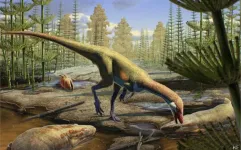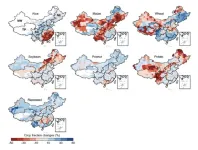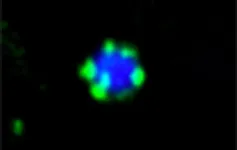(Press-News.org) A new study from the University of Adelaide and The Australian National University (ANU) has outlined the first genomic evidence of early migration from New Guinea into the Wallacea, an archipelago containing Timor-Leste and hundreds of inhabited eastern Indonesian islands.
The study, published in PNAS, addresses major gaps in the human genetic history of the Wallacean Archipelago and West Papuan regions of Indonesia – a region with abundant genetic and linguistic diversity that is comparable to the Eurasian continent – including the analysis of 254 newly sequenced genomes.
In combination with linguistic and archaeological evidence, the study shows that Wallacean societies were transformed by the spread of genes and languages from West Papua in the past 3,500 years – the same period that Austronesian seafarers were actively mixing with Wallacean and Papuan groups.
“My colleagues at the Indonesian Genome Diversity Project have been studying Indonesia’s complex genetic structure for more than a decade, but this comprehensive study provides confirmation that Papuan ancestry is widespread across Wallacea, pointing to historical migrations from New Guinea,” says lead author Dr Gludhug Ariyo Purnomo, from the University of Adelaide’s School of Biological Sciences.
“By connecting the dots between genetics, linguistics, and archaeology, we now recognise West Papua as an important bio-cultural hub and the launching place of historical Papuan seafarers that now contribute up to 60% of modern Wallacean ancestry.”
Genomic research is also becoming increasingly important for developing new medicines tailored to specific genetic backgrounds.
“In the era of precision medicine, understanding the genetic structure of human groups is vital for developing treatments that are helpful rather than harmful, with Wallacea and New Guinea having been poorly represented in past genomic surveys,” Dr Purnomo says.
Associate Professor Ray Tobler, from ANU, says Wallacea had been isolated for more than 45,000 years since the arrival of the first human groups, and the more recently arriving Papuan and Austronesian migrants reconfigured Wallacean culture by introducing new languages that diversified and intermingled to create its rich linguistic landscape.
“Our findings suggest that the Papuan and Austronesian migrations were so extensive that they have largely overwritten the ancestry of the first migrants, making the recovery of these ancient migrations from genetic data challenging,” says Professor Tobler, who is also an Adjunct Fellow at the University of Adelaide’s Australian Centre for Ancient DNA.
According to the researchers, there are challenges in reconstructing past movements of people using modern genetic data due to historical migrations and movements.
“There's also been so much movement in Wallacea in the past couple of thousand years, due to the spice trade and slavery, that it obscures the relationship between geography and genetics,” Associate Professor Tobler says.
“What we know about Wallacea and New Guinea is just the tip of the iceberg, but the use of ancient DNA can help to overcome some of these challenges and help us to understand the origins and legacy of human journeys to the region stretching back tens of thousands of years.”
END
DNA adds new chapter to Indonesia’s layered human history
2025-01-08
ELSE PRESS RELEASES FROM THIS DATE:
Many children and young people with diagnosable mental health disorders are not receiving timely help, says new research
2025-01-08
Children and young people with high levels of mental health needs are struggling to receive the help they need, or to have their difficulties recognised, according to a new study.
The STADIA trial, which is published in the Journal of Child Psychology and Psychiatry, was led by experts from the School of Medicine at the University of Nottingham, and was funded by the National Institute for Health and Care Research (NIHR).
The large study, which spans different parts of England, involved 1,225 children and young people with emotional difficulties who had been referred to Child and Adolescent Mental Health Services (CAMHS) for help, and followed them up over 18 months to see ...
Dinosaurs roamed the northern hemisphere millions of years earlier than previously thought, according to new analysis of the oldest North American fossils
2025-01-08
MADISON — How and when did dinosaurs first emerge and spread across the planet more than 200 million years ago? That question has for decades been a source of debate among paleontologists faced with fragmented fossil records. The mainstream view has held that the reptiles emerged on the southern portion of the ancient supercontinent Pangea called Gondwana millions of years before spreading to the northern half named Laurasia.
But now, a newly described dinosaur whose fossils were uncovered by University of Wisconsin–Madison paleontologists is challenging ...
Breakthrough Durham University research offers new insights into quenching electrical waves in the heart
2025-01-08
-With images-
Scientists at Durham University have developed a theoretical framework to predict the efficacy of quenching of electrical pulses in excitable media, such as those found in the human heart.
This breakthrough could significantly accelerate the development of more efficient defibrillation techniques for treating cardiac arrhythmias.
The study, published in Physical Review E, addresses a longstanding challenge in understanding how stable excitation waves in systems like cardiac tissue can be effectively neutralised through small changes.
These electrical waves, when irregular, are thought to underly serious conditions such as fibrillation, ...
SLAC will play a key role in DOE’s new research centers for advancing next-generation microelectronics
2025-01-07
Around the globe day and night, the microelectronics behind much of modern technology help run computers, medical devices and state-of-the-art instruments that power scientific discoveries. But all of that technology consumes energy, and adding artificial intelligence to the mix increases our energy needs dramatically. Some experts caution that this pace of energy usage is unsustainable.
To tackle this challenge, the Department of Energy (DOE) has announced funding $179 million for three Microelectronics ...
Market researchers and online advertisers, are A-B tests leading you astray? A new study says they could be
2025-01-07
Researchers from Southern Methodist University and University of Michigan published a new Journal of Marketing study that examines platforms’ A-B testing of online ads and uncovers significant limitations that can create misleading conclusions about ad performance.
The study, forthcoming in the Journal of Marketing, is titled “Where A-B Testing Goes Wrong: How Divergent Delivery Affects What Online Experiments Cannot (and Can) Tell You About How Customers Respond to Advertising” and is authored by Michael Braun and Eric M. Schwartz.
Consider a landscaping company whose designs focus ...
Research alert: Ketamine use on the rise in U.S. adults; new trends emerge
2025-01-07
A recent study analyzing data from the National Survey on Drug Use and Health (NSDUH) found that past-year recreational ketamine use among adults has increased dramatically since 2015, including significant shifts in associations with depression and sociodemographic characteristics such as race, age and education status. Ketamine use has shown promise in clinical trials therapy for several mental illnesses, including treatment-resistant depression, and the new research suggests that ongoing monitoring of recreational use trends is crucial to balancing these ...
Crop switching for climate change in China
2025-01-07
A study of Chinese agriculture recommends planting areas currently growing maize and rapeseed with alternative crops to reduce environmental costs while maximizing food production as the climate changes.
Chinese food production has nearly doubled since the 1980s, mainly thanks to intensified nutrient usage and irrigation. Given that China’s demand for food is forecast to increase further, Qi Guan and colleagues modeled the country’s agricultural system under varying climate change scenarios in the 21st century, using a dynamic global vegetation model. The authors created scenarios ...
Cell-based therapy improves outcomes in a pig model of heart attacks
2025-01-07
BIRMINGHAM, Ala. – In a large-animal model study, researchers have found that heart attack recovery is aided by injection of heart muscle cell spheroids derived from human induced pluripotent stem cells, or hiPSCs, that overexpress cyclin D2 and are knocked out for human leukocyte antigen classes I and II. This research, published in the journal Circulation Research, used a pig model of heart attacks. Pig hearts more closely resemble the human heart in size and physiology, and thus have a higher clinical relevance to human disease, compared to studies in mice.
University of Alabama at Birmingham researchers, led by Jianyi “Jay” ...
Researchers have a better understanding of how our cells dispose of waste while developing ways to control it
2025-01-07
Recycling takes place in our cells at all times: in a process called autophagy, cell components that are no longer needed are enclosed by membranes and broken down into their basic building blocks. This vital process prevents the formation of harmful aggregates and makes nutrients available again. A research team co-led by Prof. Dr. Claudine Kraft from the CIBSS Cluster of Excellence at the University of Freiburg and Dr. Florian Wilfling from the Max Planck Institute of Biophysics in Frankfurt has now discovered the conditions necessary for autophagy to start. They were also able ...
Earth’s air war: Explaining the delayed rise of plants, animals on land
2025-01-07
New Haven, Conn. — If you like the smell of spring roses, the sounds of summer birdsong, and the colors of fall foliage, you have the stabilization of the ozone layer to thank for it. Located in the stratosphere, where it shields the Earth from harmful ultraviolet radiation, the ozone layer plays a key role in preserving the planet’s biodiversity.
And now we may have a better idea of why that took so long — more than 2 billion years — to happen.
According to a new, Yale-led study, ...








